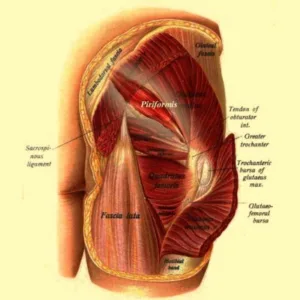Today, we’re diving into a topic that, while often overlooked, can significantly impact your daily life: Piriformis Syndrome. If you’ve experienced a nagging pain in your buttocks, especially when sitting, you might be facing this very issue. But don’t worry, our expert team at Rincon Chiropractic is here to guide you through understanding and effectively treating Piriformis Syndrome. Let’s start this journey to relief together!
Understanding Piriformis Syndrome
Anatomy and Function of the Piriformis Muscle
- The piriformis muscle is a small, deep muscle located in your buttocks.
- Its primary role is to help in rotating the hip and moving the leg away from the body.
Causes and Risk Factors
Piriformis Syndrome can be triggered by various factors:
- Muscle Spasms or Tightness: Can irritate the nearby sciatic nerve.
- Prolonged Sitting: Especially common in people with sedentary lifestyles or jobs that require long hours of sitting.
- Injury: Trauma to the buttock area can lead to the condition.
- Overuse: Frequently seen in athletes or individuals who engage in vigorous exercise.
Symptoms and Diagnosis
The diagnosis of Piriformis Syndrome involves a combination of patient history, symptoms, and physical examination:
- Symptoms:
- Pain in the buttock, often exacerbated by sitting.
- Tingling or numbness that can extend down the leg.
- Discomfort while performing activities like walking or running.
- Diagnosis:
- Physical Examination: Assessing for pain in specific areas and movements that exacerbate symptoms.
- Medical History: Understanding past injuries or activities that might have contributed to the condition.
- Differential Diagnosis: Ruling out other causes of similar symptoms, such as sciatica or lower back issues.
At Rincon Chiropractic, our approach to diagnosing and understanding Piriformis Syndrome is thorough and patient-centric. We ensure that every aspect of your condition is carefully considered in order to provide you with the most effective treatment plan.
Rincon Chiropractic’s Comprehensive Approach to Treatment
A. Chiropractic Care
- Manual Adjustments: Our chiropractors excel in manual adjustments that can help realign your spine, release muscle tension, and improve nerve function. These adjustments are not just about treating pain; they’re about restoring your body’s natural balance.
- Posture Analysis and Correction: Bad posture can be a significant contributor to Piriformis Syndrome. We’ll analyze your posture and suggest corrections, ensuring that your body works harmoniously and efficiently.
B. Complementary Therapies
- Massage Therapy Options: Our range of massage therapies, including Deep Tissue and Myofascial Release, are excellent for relieving muscle tension. These techniques can significantly reduce the pressure on your sciatic nerve, offering you much-needed relief.
- Acupuncture: This ancient practice can be surprisingly effective in treating nerve and muscle pain. By targeting specific points, acupuncture can help reduce the inflammation and pain associated with Piriformis Syndrome.
C. Exercise Therapy and Stretching
We believe in empowering you with exercises and stretches tailored to alleviate the symptoms of Piriformis Syndrome. These will not only provide immediate relief but also help prevent future occurrences.
D. Nutrition and Supplements
Nutrition often plays an underrated role in musculoskeletal health. We offer guidance on a balanced diet and recommend supplements that might aid in your recovery and overall well-being.
At Rincon Chiropractic, we understand that every patient’s journey with Piriformis Syndrome is unique. That’s why we tailor our treatments to fit your individual needs, ensuring you receive the most effective care possible.
Patient-Centered Care at Rincon Chiropractic
At Rincon Chiropractic, we believe in a holistic, patient-centered approach to healthcare. Our treatment for Piriformis Syndrome reflects this philosophy.
- Personalized Treatment Plans: Each patient receives a custom-designed treatment plan that addresses their specific symptoms and underlying causes.
- Importance of Patient Education: We focus on educating our patients about their condition, treatment options, and preventive measures to empower them in their healing journey.
Piriformis Syndrome Prevention Tips
Preventing Piriformis Syndrome is as important as treating it. Here are some strategies to help you keep this condition at bay:
Stay Active and Maintain Good Posture
Regular physical activity is crucial in maintaining muscle flexibility and strength. Practicing good posture, especially when sitting for long periods, can significantly reduce the risk of muscle tightness and nerve compression.
Stretch Regularly
Incorporating stretching exercises into your daily routine can help keep the piriformis muscle flexible and prevent spasms.
Ergonomic Adjustments
Making ergonomic adjustments to your workspace can reduce the strain on your body, particularly on the piriformis muscle and surrounding areas.
Regular Chiropractic Check-Ups
Routine chiropractic care can help maintain spinal alignment, muscle balance, and overall musculoskeletal health, thus preventing the recurrence of Piriformis Syndrome.
Final Thoughts
We’ve explored the complexities of Piriformis Syndrome and the comprehensive treatment approach at Rincon Chiropractic. Our goal is not just to alleviate your current symptoms but to empower you with the knowledge and tools for long-term health and well-being.
If you or someone you know is struggling with Piriformis Syndrome, we invite you to visit Rincon Chiropractic. Our team of dedicated professionals is here to support you on your journey to recovery. For more information or to book a consultation, please contact us. We look forward to being a part of your healing journey.





